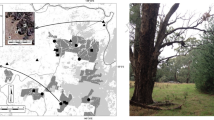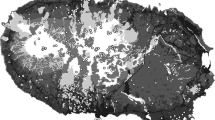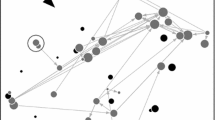Abstract
Context
Landscape-scale population dynamics are driven in part by movement within and dispersal among habitat patches. Predicting these processes requires information about how movement behavior varies among land cover types.
Objectives
We investigated how butterfly movement in a heterogeneous landscape varies within and between habitat and matrix land cover types, and the implications of these differences for within-patch residence times and among-patch connectivity.
Methods
We empirically measured movement behavior in the Baltimore checkerspot butterfly (Euphydryas phaeton) in three land cover classes that broadly constitute habitat and two classes that constitute matrix. We also measured habitat preference at boundaries. We predicted patch residence times and interpatch dispersal using movement parameters estimated separately for each habitat and matrix land cover subclass (5 categories), or for combined habitat and combined matrix land cover classes (2 categories). We evaluated the effects of including edge behavior on all metrics.
Results
Overall, movement was slower within habitat land cover types, and faster in matrix cover types. Butterflies at forest edges were biased to remain in open areas, and connectivity and patch residence times were most affected by behavior at structural edges. Differences in movement between matrix subclasses had a greater effect on predictions about connectivity than differences between habitat subclasses. Differences in movement among habitat subclasses had a greater effect on residence times.
Conclusions
Our findings highlight the importance of careful classification of movement and land cover in heterogeneous landscapes, and reveal how subtle differences in behavioral responses to land cover can affect landscape-scale outcomes.


Similar content being viewed by others
References
Baguette M, Van Dyck H (2007) Landscape connectivity and animal behavior: functional grain as a key determinant for dispersal. Landscape Ecol 22(8):1117–1129
Barton KA, Phillips BL, Morales JM, Travis JMJ (2009) The evolution of an ‘intelligent’ dispersal strategy: biased, correlated random walks in patchy landscapes. Oikos 118(2):309–319
Bates D, Maechler M, Bolker B, Walker S (2015) Fitting linear mixed-effects models using lme4. J Stat Softw 67(1):1–48
Bélisle M (2005) Measuring landscape connectivity: the challenge of behavioral landscape ecology. Ecology 86(8):1988–1995
Bender DJ, Fahrig L (2005) Matrix structure obscures the relationship between interpatch movement and patch size and isolation. Ecology 86(4):1023–1033
Berwaerts K, Van Dyck H (2004) Take-off performance under optimal and suboptimal thermal conditions in the butterfly Pararge aegeria. Oecologia 141(3):536–545
Bonte D, Van Dyck H, Bullock JM, Coulon A, Delgado M, Gibbs M, Lehouck V, Matthysen E, Mustin K, Saastamoinen M (2012) Costs of dispersal. Biol Rev 87(2):290–312
Bowers MD, Stamp NE, Collinge SK (1992) Early stage of host range expansion by a specialist herbivore, Euphydryas phaeton (Nymphalidae). Ecology 73(2):526–536
Breed GA, Stichter S, Crone EE (2013) Climate-driven changes in northeastern US butterfly communities. Nat Clim Change 3(2):142–145
Brown LM, Crone EE (2016a) Individual variation changes dispersal distance and area requirements of a checkerspot butterfly. Ecology 97(1):106–115
Brown LM, Crone EE (2016b) Minimum area requirements for an at-risk butterfly based on movement and demography. Conserv Biol 30(1):103–112
Brown LM, Breed GA, Severns PM, Crone EE (2016) Losing a battle but winning the war: moving past preference-performance to understand native herbivore-novel host plant interactions. Oecologia. doi:10.1007/s00442-016-3787-y
Cobbold CA, Lutscher F (2014) Mean occupancy time: linking mechanistic movement models, population dynamics and landscape ecology to population persistence. J Math Biol 68(3):549–579
Crone EE (2013) Responses of social and solitary bees to pulsed floral resources. Am Nat 182(4):465–473
Crone EE, Schultz CB (2003) Movement behavior and minimum patch size for butterfly population persistence. In: Boggs CL, Watt WB, Ehrlich PR (eds) Butterflies: ecology and evolution taking flight. University of Chicago Press, Chicago, pp 561–576
Delaware Division of Fish and Wildlife (2013) Wildlife species conservation and research program—Delaware’s endangered species. http://www.dnrec.delaware.gov/fw/NHESP/information/Pages/Endangered.aspx
Dennis RLH, Shreeve TG, Van Dyck H (2003) Towards a functional resource-based concept for habitat: a butterfly biology viewpoint. Oikos 102(2):417–426
Dias MP, Granadeiro JP, Palmeirim JM (2009) Searching behaviour of foraging waders: does feeding success influence their walking? Anim Behav 77(5):1203–1209
Elderd BD, Nott MP (2008) Hydrology, habitat change and population demography: an individual-based model for the endangered Cape Sable seaside sparrow Ammodramus maritimus mirabilis. J Appl Ecol 45(1):258–268
ESRI (2015) ArcMap 10.3. Environmental Systems Resource Institute: Redlands
Fahrig L, Baudry J, Brotons L, Burel FG, Crist TO, Fuller RJ, Sirami C, Siriwardena GM, Martin JL (2011) Functional landscape heterogeneity and animal biodiversity in agricultural landscapes. Ecol Lett 14(2):101–112
Fischer J, Lindenmayer DB (2006) Beyond fragmentation: the continuum model for fauna research and conservation in human-modified landscapes. Oikos 112(2):473–480
Fox J, Weisberg M (2011) An R companion to applied regression. Sage, Thousand Oaks
Frye J, Durkin P, Gibbs D, Gibbs R, Lustig M (2013) Conservation and management of the Baltimore checkerspot (Euphydryas phaeton, Drury) in Maryland: strategies for statewide monitoring and for wetland resotration, captive breeding and release in the Piedmont region. In: Maryland Department of Natural Resources W. a. H. S., Natural Heritage Program (ed), 2 edn. Annapolis
Georgia department of natural resources (2016) Special concern animals in Georgia. http://georgiawildlife.com/sites/default/files/uploads/wildlife/nongame/text/html/et_lists/span.html
Graves T, Chandler RB, Royle JA, Beier P, Kendall KC (2014) Estimating landscape resistance to dispersal. Landscape Ecol 29(7):1201–1211
Haddad NM (1999) Corridor use predicted from behaviors at habitat boundaries. Am Nat 153(2):215–227
Haila Y (2002) A conceptual genealogy of fragmentation research: from island biogeography to landscape ecology. Ecol Appl 12(2):321–334
Halstead BJ, McCoy ED, Stilson TA, Mushinsky HR (2007) Alternative foraging tactics of juvenile gopher tortoises (Gopherus polyphemus) examined using correlated random walk models. Herpetologica 63(4):472–481
Hanski I, Gilpin M (1991) Metapopulation dynamics—brief-history and conceptual domain. Biol J Linn Soc 42(1–2):3–16
Haynes KJ, Cronin JT (2004) Confounding of patch quality and matrix effects in herbivore movement studies. Landscape Ecol 19:119–124
Haynes KJ, Dillemuth FP, Anderson BJ, Hakes AS, Jackson HB, Jackson SE, Cronin JT (2007) Landscape context outweighs local habitat quality in its effects on herbivore dispersal and distribution. Oecologia 151(3):431–441
Holl KD, Crone EE (2004) Applicability of landscape and island biogeography theory to restoration of riparian understorey plants. J Appl Ecol 41(5):922–933
Homer CG, Dewitz JA, Yang L, Jin S, Danielson P, Xian G, Coulston J, Herold ND, Wickham JD, Megown K (2015) Completion of the 2011 National land cover database for the counterminous United States—representing a decade of land cover change information. Photogramm Eng Remote Sens 81(5):345–354
Hudgens BR, Morris WF, Haddad NM, Fields WR, Wilson JW, Kuefler D, Jobe T (2012) How complex do models need to be to predict dispersal of threatened species through matrix habitats? Ecol Appl 22(5):1701–1710
Iowa department of natural resources (2012) The Iowa wildlife Action plan—chapter 3: species of greatest conservation need
Kays R, Crofoot MC, Jetz W, Wikelski M (2015) Terrestrial animal tracking as an eye on life and planet. Science 348(6240):aaa2478-1
Kindlmann P, Burel F (2008) Connectivity measures: a review. Landscape Ecol 23(8):879–890
Kindvall O (1999) Dispersal in a metapopulation of the bush cricket, Metrioptera bicolor (Orthoptera: Tettigoniidae). J Anim Ecol 68(1):172–185
Knowlton JL, Graham CH (2010) Using behavioral landscape ecology to predict species’ responses to land-use and climate change. Biol Conserv 143(6):1342–1354
Koen EL, Bowman J, Walpole AA (2012) The effect of cost surface parameterization on landscape resistance estimates. Mol Ecol Resour 12:686–696
Kuefler D, Hudgens B, Haddad NM, Morris WF, Thurgate N (2010) The conflicting role of matrix habitats as conduits and barriers for dispersal. Ecology 91(4):944–950
LeGrand J, Harry E., Ratcliffe JA, Finnegan JT, North Carolina Natural Heritage Program (2014) Natural Heritage Program List of the Rare Animal Species of North Carolina
Lima SL, Zollner PA (1996) Towards a behavioral ecology of ecological landscapes. Trends Ecol Evol 11(3):131–135
Maciel GA, Lutscher F (2013) How individual movement response to habitat edges affects population persistence and spatial spread. Am Nat 182:42–52
MassGIS (2014) USGS color ortho imagery 2013/2014. http://www.mass.gov/anf/research-and-tech/it-serv-and-support/application-serv/office-of-geographic-information-massgis/datalayers/colororthos2013.html
Matter SF, Gargano C, Kim KI, Wick A (2016) Forest habitat reduces the flight of Pontia occidentalis (Reakirt) (Lepidoptera: Pieridae) relative to alpine meadow habitat. J Lepidopterists’ Soc 70(2):108–113
McClintock BT, King R, Thomas L, Matthiopoulos J, McConnell BJ, Morales JM (2012) A general discrete-time modeling framework for animal movement using multistate random walks. Ecol Monogr 82(3):335–349
McIntire EJB, Schultz CB, Crone EE (2007) Designing a network for butterfly habitat restoration: where individuals, populations and landscapes interact. J Appl Ecol 44(4):725–736
Merckx T, Van Dyck H (2005) Mate location behaviour of the butterfly Pararge aegeria in woodland and fragmented landscapes. Anim Behav 70(2):411–416
Morales JM, Ellner SP (2002) Scaling up animal movements in heterogeneous landscapes: the importance of behavior. Ecology 83(8):2240–2247
Morales JM, Haydon DT, Frair J, Holsiner KE, Fryxell JM (2004) Extracting more out of relocation data: building movement models as mixtures of random walks. Ecology 85(9):2436–2445
Morales JM, Moorcroft PR, Matthiopoulos J, Frair JL, Kie JG, Powell RA, Merrill EH, Haydon DT (2010) Building the bridge between animal movement and population dynamics. Philosophical Trans R Soc B 365(1550):2289–2301
Neumann W, Martinuzzi S, Estes AB, Pidgeon AM, Dettki H, Ericsson G, Radeloff VC (2015) Opportunities for the application of advanced remotely-sensed data in ecological studies of terrestrial animal movement. Mov Ecol 3:8
Nowicki P, Vrabec V, Binzenhofer B, Feil J, Zaksek B, Hovestadt T, Settele J (2014) Butterfly dispersal in inhospitable matrix: rare, risky, but long-distance. Landscape Ecol 29(3):401–412
Ovaskainen O, Cornell SJ (2003) Biased movement at a boundary and conditional occupancy times for diffusion processes. J Appl Probab 40(3):557–580
Ovaskainen O, Rekola H, Meyke E, Arjas E (2008) Bayesian methods for analyzing movements in heterogeneous landscapes from mark-recapture data. Ecology 89(2):542–554
Patterson TA, Thomas L, Wilcox C, Ovaskainen O, Matthiopoulos J (2008) State-space models of individual animal movement. Trends Ecol Evol 23(2):87–94
Pennsylvania Natural Heritage Program (2016) PNHP species list—insects and spiders. http://www.naturalheritage.state.pa.us/species.aspx
Perry GLW, Bond NR (2009) Spatially explicit modeling of habitat dynamics and fish population persistence in an intermittent lowland stream. Ecol Appl 19(3):731–746
Potts JR, Hillen T, Lewis MA (2016) The “edge effect” phenomenon: deriving population abundance patterns from individual animal movement decisions. Theor Ecol 9:233–247
Prevedello JA, Vieira MV (2010) Does the type of matrix matter? A quantitative review of the evidence. Biodivers Conserv 19(5):1205–1223
R Core Team (2015) R: a language and environment for statistical computing. Vienna
Reeve JD, Cronin JT, Haynes KJ (2008) Diffusion models for animals in complex landscapes: incorporating heterogeneity among substrates, individuals and edge behaviours. J Anim Ecol 77(5):898–904
Revilla E, Wiegand T (2008) Individual movement behavior, matrix heterogeneity, and the dynamics of spatially structured populations. Proc Natl Acad Sci USA 105(49):19120–19125
Ricketts TH (2001) The matrix matters: effective isolation in fragmented landscapes. Am Nat 158(1):87–99
Ries L, Debinski DM (2001) Butterfly responses to habitat edges in the highly fragmented prairies of Central Iowa. J Anim Ecol 70(5):840–852
Ross JA, Matter SF, Roland J (2005) Edge avoidance and movement of the butterfly Parnassius smintheus in matrix and non-matrix habitat. Landscape Ecol 20:127–135
Ruel JJ, Ayres MP (1999) Jensen’s inequality predicts effects of environmental variation. Trends Ecol Evol 14(9):361–366
Schneider C (2003) The influence of spatial scale on quantifying insect dispersal: an analysis of butterfly data. Ecol Entomol 28(2):252–256
Schtickzelle N, Baguette M (2003) Behavioural responses to habitat patch boundaries restrict dispersal and generate emigration-patch area relationships in fragmented landscapes. J Anim Ecol 72:533–545
Schtickzelle N, Joiris A, Van Dyck H, Baguette M (2007) Quantitative analysis of changes in movement behaviour within and outside habitat in a specialist butterfly. BMC Evol Biol 7:4
Schultz CB (1998) Dispersal behavior and its implications for reserve design in a rare Oregon butterfly. Conserv Biol 12(2):284–292
Schultz CB, Crone EE (2001) Edge-mediated dispersal behavior in a prairie butterfly. Ecology 82(7):1879–1892
Schultz CB, Franco AMA, Crone EE (2012) Response of butterflies to structural and resource boundaries. J Anim Ecol 81(3):724–734
Severns PM, McIntire EJB, Schultz CB (2013) Evaluating functional connectivity with matrix behavior uncertainty for an endangered butterfly. Landscape Ecol 28(3):559–569
Siu JC, Koscinski D, Keyghobadi N (2016) Swallowtail butterflies show positive edge responses predicted by resource use. Landscape Ecol. doi:10.1007/s10980-016-0385-7
Skellam JG (1951) Random dispersal in theoretical populations. Biometrika 38(1–2):196–218
Skórka P, Nowicki P, Lenda M, Witek M, Śliwińska EB, Settele J, Woyciechowski M (2013) Different flight behaviour of the endangered scarce large blue butterfly Phengaris teleius (Lepidoptera: Lycaenidae) within and outside its habitat patches. Landscape Ecol 28(3):533–546
Spear SF, Balkenhol N, Fortin MJ, McRae BH, Scribner K (2010) Use of resistance surfaces for landscape genetic studies: considerations for parameterization and analysis. Mol Ecol 19(17):3576–3591
Stevens VM, Polus E, Wesselingh RA, Schtickzelle N, Baguette M (2004) Quantifying functional connectivity: experimental evidence for patch-specific resistance in the Natterjack toad (Bufo calamita). Landscape Ecol 19(8):829–842
Taylor PD, Fahrig L, Henein K, Merriam G (1993) Connectivity is a vital element of landscape structure. Oikos 68(3):571–573
Tischendorf L (2001) Can landscape indices predict ecological processes consistently? Landscape Ecol 16(3):235–254
Turchin P (1991) Translating foraging movements in heterogeneous environments into the spatial-distribution of foragers. Ecology 72(4):1253–1266
Turchin P (1998) Quantitative analysis of movement: measuring and modeling population redistribution in animals and plants. Sinauer Associates Inc, Sunderland
Turlure C, Van Dyck H, Schtickzelle N, Baguette M (2009) Resource-based habitat definition, niche overlap and conservation of two sympatric glacial relict butterflies. Oikos 118(6):950–960
Turner MG, Gardner RH, O’Neill RV (2001) Landscape ecology in theory and practice. Springer-Verlag, New York
Vanreusel W, Van Dyck H (2007) When functional habitat does not match vegetation types: a resource-based approach to map butterfly habitat. Biol Conserv 135(2):202–211
White JW, Rassweiler A, Samhouri JF, Stier AC, White C (2014) Ecologists should not use statistical significance tests to interpret simulation model results. Oikos 123(4):385–388
Wiens JA (1989) Spatial scaling in ecology. Funct Ecol 3(4):385–397
Wiens JA, Stenseth NC, Vanhorne B, Ims RA (1993) Ecological mechanisms and landscape ecology. Oikos 66(3):369–380
Wilensky U (1999) NetLogo. Center for connected learning and computer-based modeling. Northwestern University, Evanston
Zeller KA, McGarigal K, Whiteley AR (2012) Estimating landscape resistance to movement: a review. Landscape Ecol 27(6):777–797
Zeller KA, McGarigal K, Cushman SA, Beier P, Vickers TW, Boyce WM (2016) Using step and path selection functions for estimating resistance to movement: pumas as a case study. Landscape Ecol 31(6):1319–1335
Zollner PA, Lima SL (1999) Search strategies for landscape-level interpatch movements. Ecology 80(3):1019–1030
Acknowledgements
We are grateful to many helpful assistants in the field, including M. Bogdziewicz, D. Donnelly, N. Kerr, C. B. Schultz, N. Tigreros, N. Warchola, G. Wardle, and R. Zwolak. We also thank J. Hepinstall-Cymerman for helpful conversations as this manuscript was being developed. This research was supported by a DoD SERDP (RC-2119) to E. E. Crone, a NSF PRFB (1402287) to L. M. Brown, NSF REU program funding through Tufts University (1005082 to Philip Starks and Colin Orians and 1560380 to Philip Starks) to H. Coffmann, A. Kazberouk and E. Kemper, and funding from the Belgian Fund for Scientific Research F.R.S.FNRS to N. Schtickzelle.
Author information
Authors and Affiliations
Corresponding author
Electronic supplementary material
Below is the link to the electronic supplementary material.
Rights and permissions
About this article
Cite this article
Brown, L.M., Fuda, R.K., Schtickzelle, N. et al. Using animal movement behavior to categorize land cover and predict consequences for connectivity and patch residence times. Landscape Ecol 32, 1657–1670 (2017). https://doi.org/10.1007/s10980-017-0533-8
Received:
Accepted:
Published:
Issue Date:
DOI: https://doi.org/10.1007/s10980-017-0533-8




